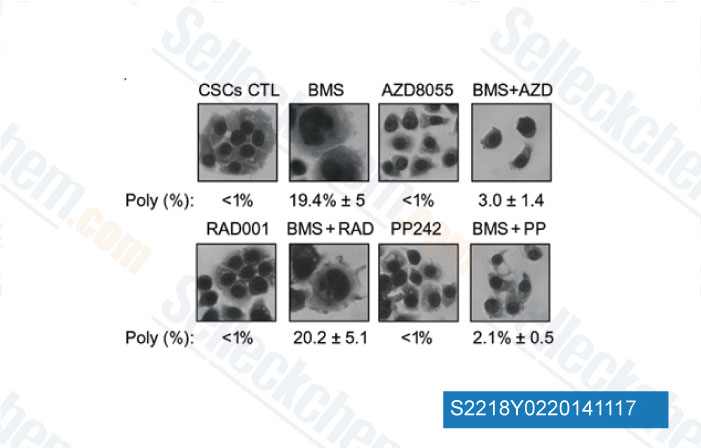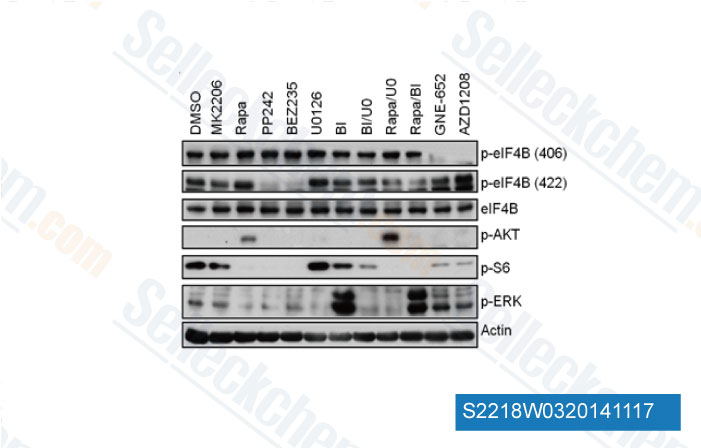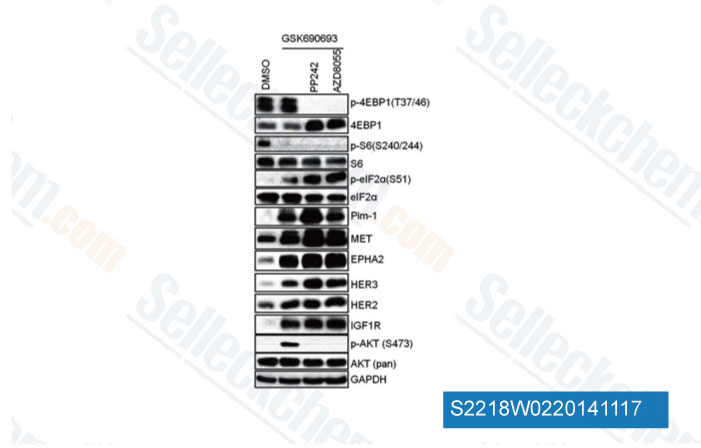|
Toll Free: (877) 796-6397 -- USA and Canada only -- |
Fax: +1-832-582-8590 Orders: +1-832-582-8158 |
Tech Support: +1-832-582-8158 Ext:3 Please provide your Order Number in the email. |
Technical Data
| Formula | C16H16N6O |
|||
| Molecular Weight | 308.34 | CAS No. | 1092351-67-1 | |
| Solubility (25°C)* | In vitro | DMSO | 62 mg/mL (201.07 mM) | |
| Water | Insoluble | |||
| Ethanol | Insoluble | |||
|
* <1 mg/ml means slightly soluble or insoluble. * Please note that Selleck tests the solubility of all compounds in-house, and the actual solubility may differ slightly from published values. This is normal and is due to slight batch-to-batch variations. * Room temperature shipping (Stability testing shows this product can be shipped without any cooling measures.) |
||||
Preparing Stock Solutions
Biological Activity
| Description | Torkinib (PP242) is a selective mTOR inhibitor with IC50 of 8 nM in cell-free assays; targets both mTOR complexes with >10- and 100-fold selectivity for mTOR than PI3Kδ or PI3Kα/β/γ, respectively. Torkinib (PP242) induces mitophagy and apoptosis. | ||||||||
|---|---|---|---|---|---|---|---|---|---|
| Targets |
|
||||||||
| In vitro | PP242 exhibits potent selectivity for mTOR over other PI3K family kinases such as p110α, p110β, p110γ, p110δ, and DNA-PK with IC50 of 1.96 μM, 2.2 μM, 1.27 μM, 0.102 μM, and 0.408 μM, respectively. PP242 displays some inhibitory activity against Ret, PKCα, PKCβ, and JAK2, while exhibits remarkable selectivity against 215 other protein kinases. Unlike rapamycin, PP242 inhibits both mTORC1 and mTORC2. In BT549 cells, PP242 treatment (0.04-10 μM) inhibits the phosphorylation of Akt, the mTOR substrate p70S6K, and its downstream target S6 in a dose-dependent manner. [1] PP242 potently inhibits PKCα with IC50 of 49 nM. Low concentrations of PP242 inhibit the phosphorylation of Akt S473 and higher concentrations partially inhibit Akt T308-P in addition to S473-P. As PP242 is a more effective mTORC1 inhibitor than rapamycin, PP242 inhibits the proliferation of primary MEFs, and the phosphorylation of 4EBP1 at T36/45 and S65, more potently than rapamycin. PP242 but not rapamycin potently inhibits cap-dependent translation, by causing a higher level of binding between 4EBP1 and eIF4E than rapamycin. [2] PP242 potently inhibits the proliferation of p190-transformed murine BM, SUP-B15, and K562 cells with GI50 of 12 nM, 90 nM, and 85 nM, respectively. PP242 also inhibits the growth of solid tumor cell lines such as SKOV3, PC3, 786-O, and U87 with GI50 of 0.49 μM, 0.19 μM, 2.13 μM, and 1.57 μM, respectively. [3] PP242 is also more effective than rapamycin in achieving cytoreduction and apoptosis in multiple myeloma (MM) cells. [4] | ||||||||
| In vivo | Administration of PP242 is able to completely inhibit the phosphorylation of Akt at S473 and T308 in fat and liver of mice. PP242 only partially inhibits the phosphorylation of Akt in skeletal muscle and is more effective at inhibiting the phosphorylation of T308 than S473, despite able to fully inhibit the phosphorylation of 4EBP1 and S6. [2] Oral administration PP242 potently delays the leukemia onset in the mice model, and induces leukemia regression by inhibiting mTORC2 and mTORC1 activation that correlates with loss in cell size. [3] PP242 treatment potently inhibits the growth of 8226 cells in mice. [4] | ||||||||
| Features | One of the first selective inhibitors that targets ATP domain of mTOR. |
Protocol (from reference)
| Kinase Assay:[1] |
|
|---|---|
| Cell Assay:[2] |
|
| Animal Study:[3] |
|
References
Customer Product Validation

-
Data from [Data independently produced by Mol Cancer Ther, 2014, 13(1), 37-48]

-
Data from [Data independently produced by Mol Cell Biol, 2014, 34(13), 2517-32]

-
Data from [Data independently produced by Cancer Res, 2013, 73(11), 3402-11]

-
Data from [Data independently produced by Autophagy, 2012, 8(6), 903-14]
Selleck's Torkinib (PP242) has been cited by 108 publications
| mTORC1 restricts TFE3 activity by auto-regulating its presence on lysosomes [ Mol Cell, 2024, S1097-2765(24)00832-3] | PubMed: 39486419 |
| Akt enhances the vulnerability of cancer cells to VCP/p97 inhibition-mediated paraptosis [ Cell Death Dis, 2024, 15(1):48] | PubMed: 38218922 |
| The mevalonate pathway contributes to breast primary tumorigenesis and lung metastasis [ Mol Oncol, 2024, 10.1002/1878-0261.13716] | PubMed: 39119789 |
| WWP1 inhibition suppresses the proliferation of pancreatic cancer cells by regulating the PI3K-AKT pathway [ J Gastroenterol, 2024, 10.1007/s00535-024-02192-x] | PubMed: 39656237 |
| Casein kinase 1α mediates phosphorylation of the Merkel cell polyomavirus large T antigen for β-TrCP destruction complex interaction and subsequent degradation [ mBio, 2024, 15(8):e0111724] | PubMed: 38940554 |
| TRIM44, a Novel Prognostic Marker, Supports the Survival of Proteasome-Resistant Multiple Myeloma Cells [ Cells, 2024, 13(17)1431] | PubMed: 39273003 |
| Mcam stabilizes a luminal progenitor-like breast cancer cell state via Ck2 control and Src/Akt/Stat3 attenuation [ NPJ Breast Cancer, 2024, 10(1):80] | PubMed: 39277578 |
| TRIM44 enhances autophagy via SQSTM1 oligomerization in response to oxidative stress [ Sci Rep, 2024, 14(1):18974] | PubMed: 39152142 |
| TRIM44 promotes autophagy through SQSTM1 oligomerization in the response to oxidative stress induced by Arsenic Trioxide in cancer cells [ Res Sq, 2024, rs.3.rs-3951960] | PubMed: 38464079 |
| Spatial patterns of the cap-binding complex eIF4F in human melanoma cells [ Comput Struct Biotechnol J, 2023, 21:1157-1168] | PubMed: 36789267 |
RETURN POLICY
Selleck Chemical’s Unconditional Return Policy ensures a smooth online shopping experience for our customers. If you are in any way unsatisfied with your purchase, you may return any item(s) within 7 days of receiving it. In the event of product quality issues, either protocol related or product related problems, you may return any item(s) within 365 days from the original purchase date. Please follow the instructions below when returning products.
SHIPPING AND STORAGE
Selleck products are transported at room temperature. If you receive the product at room temperature, please rest assured, the Selleck Quality Inspection Department has conducted experiments to verify that the normal temperature placement of one month will not affect the biological activity of powder products. After collecting, please store the product according to the requirements described in the datasheet. Most Selleck products are stable under the recommended conditions.
NOT FOR HUMAN, VETERINARY DIAGNOSTIC OR THERAPEUTIC USE.
